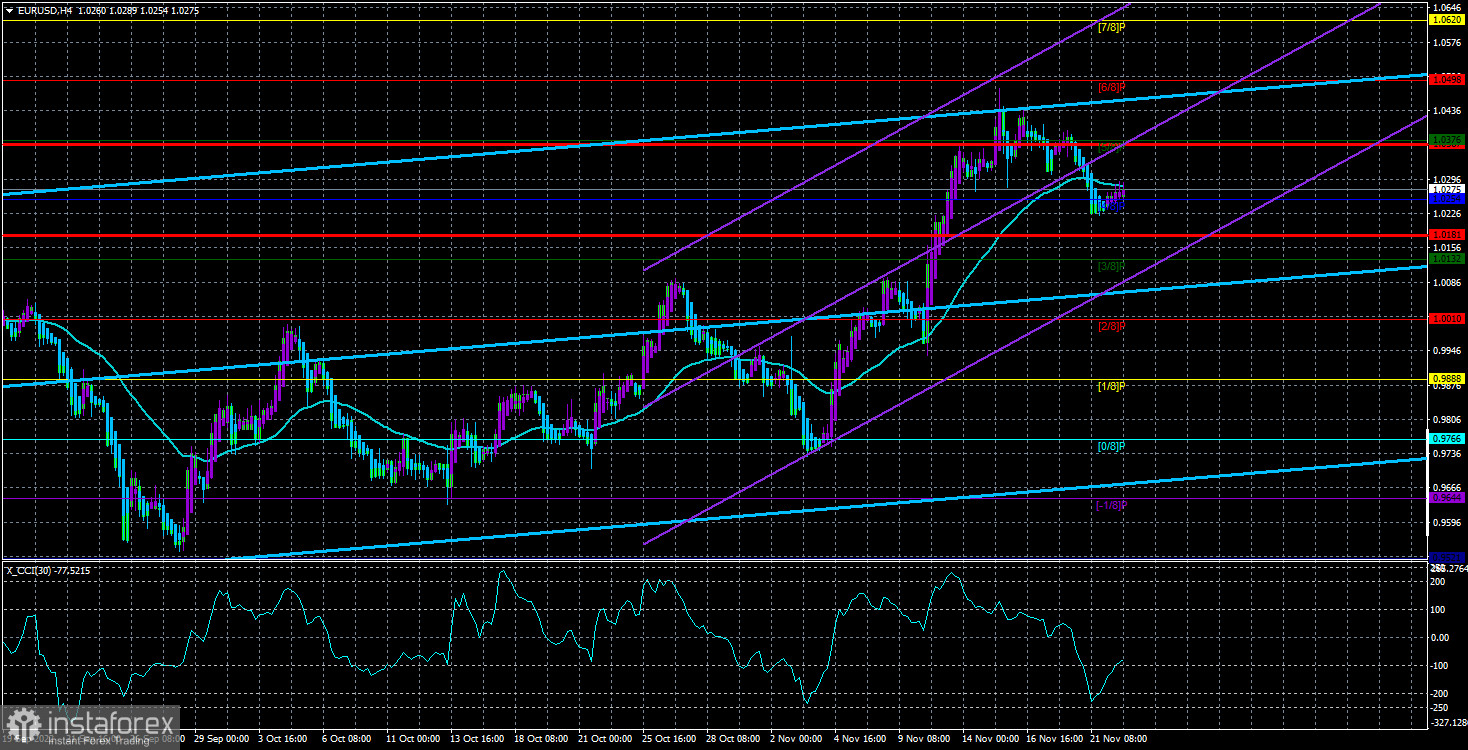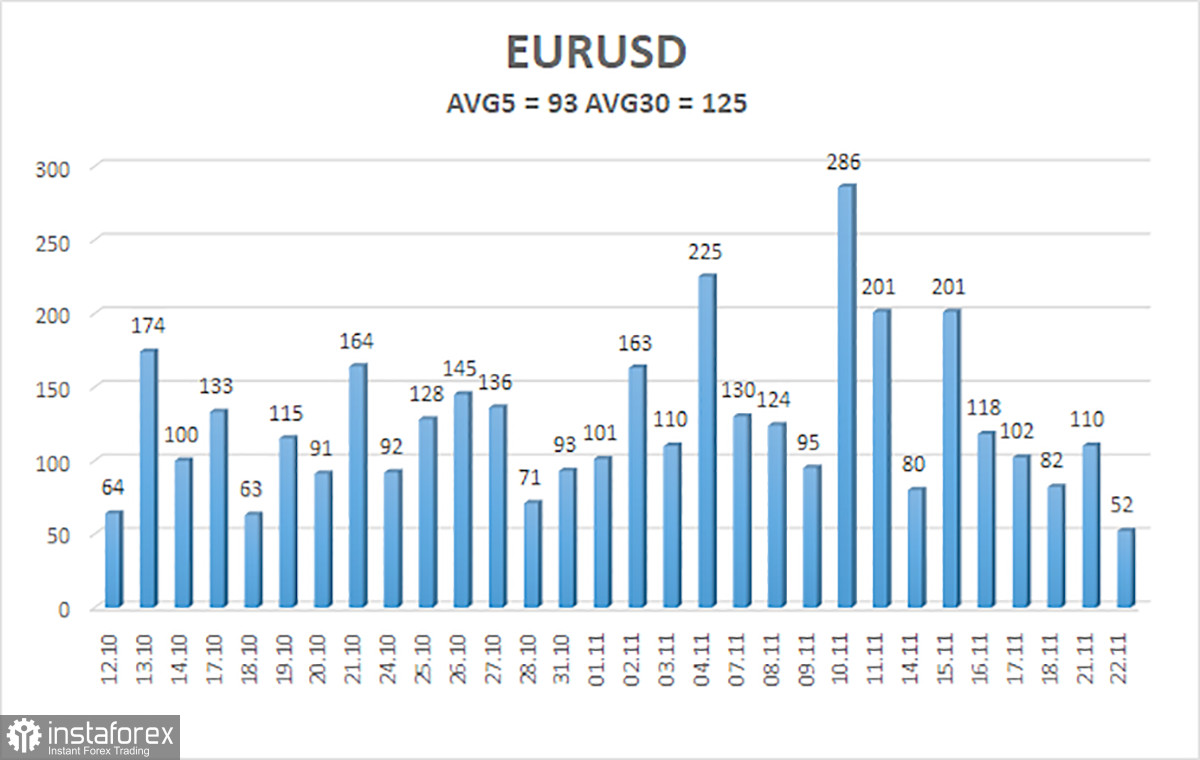
On Tuesday, the EUR/USD currency pair showed zero interest in the volatile movement. As we've already stated, it is challenging to anticipate volatile movements without fundamental and macroeconomic backgrounds. After all, these backgrounds weren't just missing last week; they were also missing locally. The market now has nothing to trade on because it has gradually processed all the available data. Because of this, over the past week and a half, we have seen relatively indistinct movements that resemble a flat more than a trend. The pair still fell by 70–80 points on Monday despite consolidating below the moving average line, so there isn't a clear flat. However, the movement is still unsatisfactory, especially on the lowest TF.
We are forced to think about the "technique" because macroeconomics and the "foundation" are nonexistent now. The "technique" has made everything clear at this point. Given that the trend has shifted downward and there has been consolidation below the moving average, it is reasonable to anticipate further declines in the euro's value. Also, keep in mind that the pair's entire prior growth was illogical from our perspective; therefore, a potential fall this week or next week will already be logical. Right now, there are a few things that could help the euro's growth. They weren't numerous before, and they're even less prevalent now. Remember that the Fed's slowing pace of tightening its monetary policy is not a "dovish" factor that would be able to cause the dollar to decline. A rate cut or implementing a quantitative stimulus plan is the "dovish" factor. The Fed is not currently engaging in any practice. It's a two-edged sword that the ECB might raise rates for a while at a slightly faster pace than the Fed. After all, the Fed's rate is still higher, and there is more confidence in the US dollar than in the euro. So, in any case, we do not anticipate a significant increase in the euro's value.
The majority of Fed members concur.
We should reexamine the subject that has been well-known to everyone for a long time since there is, for the most part, nothing to discuss. In theory, even before Mary Daly and Rafael Bostic's speeches this week, we were certain that the Fed would only increase interest rates in December by 0.5%. However, the Federal Reserve board members did nothing more than reiterate what market participants had long believed. The rate will slow down in growth, increasing by 0.5% in December and 0.25% in February and March. The final rate level is 5%, though it may be slightly adjusted upward if inflation slows down too slowly. This forecast is what should guide our current "dancing."
The present dollar exchange rate is no longer impacted by knowledge of the Fed's potential future actions. Theoretically, the euro can strengthen further against the dollar as the difference in interest rates between the ECB and the Fed is expected to close in the coming months. The euro currency can now grow, whereas the US currency previously grew as the gap widened. Therefore, we only partially rule out the possibility of the pair continuing to grow. However, the likelihood of further growth is only 30%, while the likelihood of a new fall is 70%. The pair's failure to swiftly reenter the area above the moving average yesterday favors the dollar. The pair has recently grown too quickly, necessitating a technical downward correction that benefits the dollar. The euro has no new growth drivers, which also benefits the dollar. The pair may not experience a significant decline, but another 100 to 200 points should be lost.

As of November 23, the euro/dollar currency pair's average volatility over the previous five trading days was 93 points, which is considered "high." So, on Wednesday, we anticipate the pair to fluctuate between 1.0181 and 1.0367. The Heiken Ashi indicator's downward turn indicates that the downward movement has resumed.
Nearest levels of support
S1 – 1.0254
S2 – 1.0132
S3 – 1.0010
Nearest resistance levels:
R1 – 1.0376
R2 – 1.0498
R3 – 1.0620
Trading Suggestions:
An upward correction has begun for the EUR/USD pair. Therefore, in the event of a downward reversal of the Heiken Ashi indicator or a price rebound from the moving average, new short positions with targets of 1.0181 and 1.0132 should now be considered. After the price fixing is above the moving average line with targets of 1.0367 and 1.0498, purchases will become pertinent.
Explanations of the illustrations:
Linear regression channels – help determine the current trend. The trend is strong if both are directed in the same direction.
The moving average line (settings 20.0, smoothed) – determines the short-term trend and the direction in which trading should be conducted now.
Murray levels – target levels for movements and corrections.
Volatility levels (red lines) – the likely price channel in which the pair will spend the next day, based on current volatility indicators.
The CCI indicator – its entry into the oversold area (below -250) or into the overbought area (above +250) means that a trend reversal in the opposite direction is approaching.





















